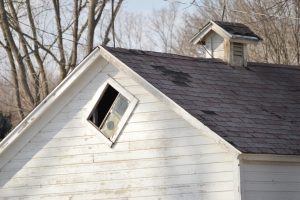As New Englanders, we’re no strangers to storms. Wind, rain, sleet and ice can all leave a roof looking a little under the weather. After a storm blows through, you might notice a few asphalt shingles missing from your roof. Or maybe there is no storm, but you own a beautiful older home and some of the shingles are damaged or badly worn. You don’t think it’s a big deal, but then you start wondering. Will my roof leak? It’s definitely possible!
It’s important to get missing shingles replaced as soon as possible to prevent further damage and expenses down the line. Being proactive with your roof repair will save you hundreds of dollars and bring you peace of mind.
Why, Generally, a Missing Shingle is Cause for Concern
When shingles are missing it allows the wind to get between the roof deck and roof shingles causing the “non-missing” ones to lift and come unsealed. There is a one in three chance that the missing shingle sat above an open seam between the shingles below. The standard 3-tab shingles are installed side-by-side with each new row of shingles covering the top of the layer below and the side seams.
Shingles are installed in layers to wick water away from the wood underneath. Each layer is composed of 3-shingle sections that are laid next to each other, end to end. When roofers add new layers of shingles during installation, they stagger the seams so water can’t get in. If a shingle above a seam tears off, water can flow into the newly unprotected gap between the lower shingles, leading to rotted plywood and roof leaks.
Sometimes your missing shingle doesn’t reveal a seam, but your roof may still be in danger of leaking. The upper portion of the shingle has less protective mineral granules than the bottom. These granules protect the shingle from the sun. When the upper portion of the shingle is exposed, the UV rays might cause it to decay and the rest of the shingles will follow suit. This will eventually lead to leaking, water damage, and mold. No matter their placement on the roof, all missing shingles can lead to roof leaks. Generally, it’s best to address these issues as soon as possible.
The Details Behind Damage from Missing Shingles
- Water: For a while, the felt paper below any missing shingles will shield your house from water damage. However, a missing asphalt shingle isn’t something you should leave unattended for too long. Left unfixed, you could be in danger, especially during heavy rain which can be common on Boston’s South Shore. Once under the shingles, water will rot the wood sheathing beneath. This can also harm your attic, ceiling joists, rafters, wall framing, and more. Rotting wood leads to structural instability in the home and seriously expensive damage. Leaking water is also a hazard because it leads to electrical issues and fire hazards when electrical systems are in close proximity to the leaking roof.
- Mold: Mold and mildew can develop as a result of the moisture coming in through the damaged roof. Mold can ruin paint, walls, clothing, furniture, carpets, and rugs, not to mention cause health-related harm to people who have allergies or respiratory problems.
- Ice: When the New England winter arrives, freezing water can lead to other issues. When the water which has entered the home freezes, it expands. This leads to cracks in the roof or framing of the house. It’s a slippery slope as the cracks allow more water to seep in – which makes the structure more unstable. You can read more about the impact of ice on roofs here, here, and here.
- Increased Energy Bills: A roof with a hole in it is permeable. With a missing shingle, you will find it harder to keep your home warm or cold depending on the season and this will increase your energy bills.
How Our South Shore Roofing Company Can Help
As with many other home issues, it’s better to fix the problem of a missing asphalt shingle sooner rather than later. Our roofing contractor experts at South Shore Roofing can fix your home or commercial roof before it starts leaking. We’ll help keep your family, employees, or tenants safe and dry! So, please reach out any time to discuss roof damages and the best solutions.








